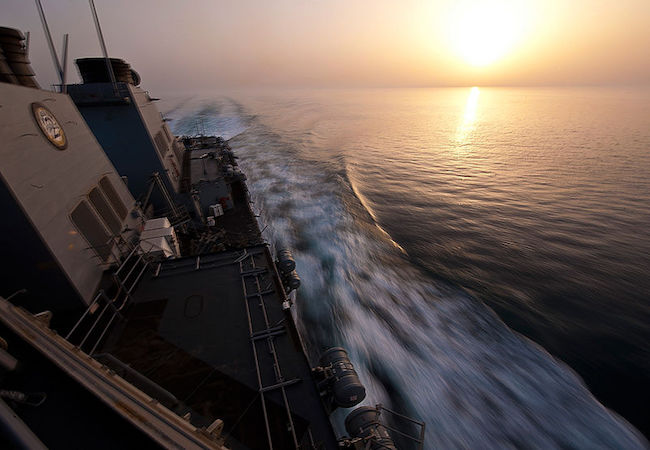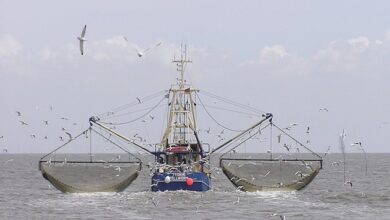African and Middle Eastern littorals and chokepoints at the center of Iran’s Fourth Generation Warfare Strategy

By Ben Minick and Irina Tsukerman
Strategic Realignment in the Strait of Hormuz
Littorals or other chokepoints along the coastline have become an increasingly large factor when conducting naval warfare. When considering such things naval forces or their Marine counterparts are not usually considered experts in shoreline tactics with the exception of specialized teams. The necessity of establishing dominance in this aspect becomes very important.
The necessary employment of various vehicles and troops changes depending upon the terrain that the fighting forces find themselves operating in. It is not the same as conducting warfare on the open ocean and must be considered when preparing any strategy for combat or security. If military leaders fail to prepare correctly they might find themselves at a severe disadvantage.
Naval joint operations with other branches of the US military service are commonplace however as the technological advances of these forces increases so does the necessity for each particular force to operate autonomously on its own so that resources can be spread and focused during battle. However, defense of the shoreline and creating chokepoints and shipping lanes also have their advantages outside of hostilities.
In this piece we will be looking at the areas around Yemen and Oman and examine how the contention around African littorals loops in to create additional risks in this strategic region. Traditionally these areas are looped into the grouping of the Persian Gulf and the Middle East theater of action. Because of their direct access to the waterways it is important to focus here. The simple truth of the matter is that the United States is not involved in any open hostilities with either of these locations, however there is a consistent threat that is posed.
International maritime law allows for the safe transport of goods and materials through international shipping lanes without violating the sovereignty of a country’s territorial waters. While this sounds simple in theory enforcing such things has proven to be difficult. For various reasons generally connected to political and economical gain piracy has become a big business in the area. Most recently the Houthi rebels in Yemen seized the distraction caused by tensions between the United States and Iran as an opportunity to steal an oil tanker and detain its crew.
While this incident garnered high-profile media attention this is not a new development in the area. Oman and Yemen both have a history of causing trouble in the vicinity. If the United States military had a larger presence in the immediate area such as outposts on the littorals it would be much easier for the Navy to conduct interdiction missions and reduce the threat to international shipping. While doing this would not exactly eliminated the threat it would greatly reduce certain aspects of it. Oman has offered to host US Navy, providing it with strategic access to Africa and the rest of the Middle East. However, given the asymmetrical nature of Iran-backed attacks in the vicinity, the presence of the larger ships in the Omani ports alone may not be a sufficient deterrent.
Creating chokepoints throughout the Middle East region outside of the main thoroughfares would also heighten security when it comes to naval threats. The Navy generally does a good job of keeping track of international vessels in the vicinity, however when problems occur it is not always easy to deploy the correct resources to reduce the tensions before they become international incidents. The average American citizen has no idea how often naval incursions take place. One illustration is the recent incident of the Iranian speedboats harassing US ships. Although the United States has threatened to attack in the event of future such incidents, the concern about escalating confrontations will likely continue to give pause to decisive action.
It is imperative that the United States work with its allies in the area to establish better shoreline security and a larger presence in the region. Often times the simple act of having forces nearby can reduce threats out of fear of retribution. This is not to say that the United States military ought to move into the vicinity and take everything over, it is just a suggestion that they develop a new policy for placement of troops and resources throughout the region to monitor the situation on a regular basis and reduce the amount of activity that is counterproductive to international policy. Although the oil tanker crisis has subsided for the time being, the threat of renewed attacks remain so long as Iran continues pushing its agenda. Saudi Arabia’s naval capabilities are practically non-existent; it has zero submarines compared to Iran’s forty; one of the concerns, in addition to aggressive maneuvers and harassment of ships, has been the heightened risk of planted mines along the littorals.
Other Middle Eastern allies likewise lack the competitive edge to address some of these issues. US has been successful in intercepting ships smuggling contraband to the Houthis in Yemen; however, despite several well-publicized interventions, the flow of weapons continues at a steady pace. One reason for that is the Oman route, which is more conducive to the use of fast smuggler boats than to large ships easily visible to the US and other naval forces stationed in the vicinity. However, investment into huge naval forces may not be necessary to deter all threats. Latest Israeli developments promise a combination of drone and laser capabilities that could be far more effective against asymmetrical threats.
A large factor that is often discussed when policy comes up as the cost to maintain a presence in the area. There is no way around this: maintaining troops and equipment is going to cost money that doesn’t necessarily mean that there has to be larger expenditures. The costs of disrupting the flow of commerce could be far greater than investment in effective deterrence for all involved. For the sake of security, it make sense to spread the resources that are already in the theater of action out so that they are not clustered in one particular area that often times draws attention from hostile actors such as Iran.
Hostilities with Iran often times cause flareups throughout the region for the simple fact that the Iranian regime is the financial benefactor of many of various proxy groups. By establishing a better security perimeter the US Navy and Marine Corps would be able to disrupt supply lines to the same groups that are actively attempting to target them and wreak havoc all over the Gulf. It makes more sense to space everything out and be able to form a secured perimeter including but not limited to the shipping lanes.
David Vincent of former Lieut. Cmdr. with the United States Navy suggests that a new policy might also usher in a new wave of violence should the US military become the cause of a true disruption to supply lines. He also indicates that such a show of force in the region might unsettle countries that are considered allies of the United States. This would be more of an adjustment. And over time such incidents would reduce as with the likelihood of further violence. In other words, Iran and its proxies may temporarily become more aggressive in response, but as their resources are drained, will be eventually forced to reconsider their strategy.
It would just be considered good practice. If our political apparatus can do a better job of explaining to our allies what our purpose is in the region are and the economic value of having higher security then things won’t be so cut and dry. The French, British, and Australian naval forces are already present, but as with the United States, they are fairly focused on the same area around the Strait of Hormuz, whereas the evidence increasingly points to Iran using other routes to address its needs; furthermore, the advantage of small speedboats is that they can come from any directions.
Asian allies, such as Japan and South Korea, too should have at least a limited presence in the area, if only to show a united front with the United States and to send a stronger message. Until recently, Japan has tried to play the role of a mediator between Iran and the United States; however, its own tankers proved not to be immune to apparently mistaken attacks by the IRGC. Japan may view a request to implement visible security in the region as being forced to take sides; however, increasingly, it is looking that the “Cold War” scenario with Iran is unavoidable, as it is forging closer relationships with other international aggressors, such as China. Everybody wants to save money and everybody wants a little more security when they go to sleep at night.
Security events of the last two decades such as the bombing of the USS Cole, the takeover of oilfields in the region and the abduction of ships lend credence to the necessity for a new development and policy. If applicable chokepoints had been created than some of these things would not have happened, or if they had happened it wouldn’t have taken everybody by surprise. Indeed, the absence of effective surveillance, including by drones, in the region, and the attacks on a US drone, which had occurred with impunity, raise questions about the overall US preparedness for escalating aggression. Historically Oman and Yemen are hotspots for anti-US sentiment in the region; being able to catch the US or others by surprise in the area speaks to effective psychological warfare as much as to the technical capabilities of the rogue actors.
A larger and smarter presence in the area would signify that the US is not scared to confront these hostile actors in support of international commerce. Also, threats would be minimized if the US Navy and Marine Corps were willing to take more frequent non-lethal deterrent action, such as electronic jamming and cyberattacks to disrupt adversarial operations and to prevent attacks.
In the event of hostilities the military units would already be in position and could just switch to a defensive stance. That would cut down on the amount of time needed to get resources into an area and establish a defensive posture. By focusing on these now during a time of relative peace, we may be able to avoid future conflicts altogether.
African Littorals As Points of Contention in Fourth Generation Warfare
While African littorals have been more closely associated with piracy for gain, such as in the case of the Somali pirates, than with any strategic state-backed acts of aggression, in reality one cannot look at the security of the Strait of Hormuz and international oil trade without examining the Horn of Africa portion of the journey for the tankers delivering oil and gas. More than just essential trade routes, in theory protected by the US naval presence in Oman, however, these areas are also smuggling routes for Iran, Qatar, Turkey, and other actors behind the funding and arming of aggressive anti-Western actors Yemen, as well as strategic battleground for growing regional presence for many states.
The US, by focusing almost exclusively on the Strait of Hormuz is missing out an opportunity to minimize the likelihood of tensions and conflicts before they reach the vulnerable chokepoint in the Middle East. Despite limited naval resources, the Middle Eastern allies of the US are aware of this threat. Eight states formed a new littoral-council, which met in Riyadh on January 7, and which, after years of discussion is being pushed forward by the Saudis. This move led to some tensions with Egypt, which is party to the agreement, and the land-locked Kenya. Somalia is included in the council, but not Somaliland, which has led to other diplomatic issues.
On the security front, the participation of Somalia, which remains under heavy influence of Turkey and Qatar, considered adversarial influences by Egypt, Saudis, and others raises questions about the effectiveness of this group on larger strategic issues beyond deterring piracy and human trafficking. Sudan is moving closer to the Saudi bloc, but is dealing with its own transitional issues and challenges, and is limited in the role it can play. The European Union had been promoting the idea of a Red Sea body, in part in response to the escalating tensions with Iran. On the other hand, many countries of the EU are fully cooperating with Iran on many issues, positioning themselves for a conflict of interest in this regard. Another concern was the movement of the Gulf Crisis to Africa. The United States has failed to take advantage of this growing base and resource race largely driven by the Qatar-UAE economic and military competition, and later, a battle for hearts and minds, with increasing involvement from Turkey and Iran’s Islamist bloc. For Europe, illegal migration has been one of the primary concerns in this scenario, with potentially millions of illegal, low-skilled and unvetted migrants making their way into European states by way of these regions, as well as from Libya via Tunisia and Morocco sea routes.
Turkey had effectively weaponized the flow of these migrants in an effort to ensure European backing of Turkish interests in Libya and Syria. For Saudi Arabia, prevention of continuous flow of weapons that are then used to attack the Kingdom, has been a top priority. Egypt, on the other hand, has been concerned about increased foreign involvement which would include China, the United States, Japan, Italy, and France, all of which maintain a base in Djibouti, with US and France also being active in counterterrorism operations in the Sahel. The absence of an active US role in these negotiations, which could have smoothed over the tensions with Egypt and strengthened the alliance through implementation of concrete terms to safeguard the relevant interests in a more structured and enforceable ways is yet another illustration of the current policy of avoiding entanglement in foreign alliance and multilateral agreements is on the one hand place less responsibility on US role in regional security, but on the other hand limits its potential influence and the ability to position itself to stake out its own interests and priorities assertively.
Ethiopia and Eritrea, two of the Red Sea nations affected by the agreement, are likewise struggling with balancing their interests in a more secure maritime environment with the unwelcome interventionism of foreign forces. Eritrea is suspicious of the Saudi influences; by the same token, Ethiopia has been under sway of Turkish and Qatari forces vis-a-vis Egypt, which creates additional tensions in the current scenario. It is unclear whether Saudi Arabia has the diplomatic wherewithal to offset these conflicting interests. Ethiopia, Egypt, and Sudan are still battling over the Blue Nile water rights while trying to resolve (unsuccessfully) the issues related to the implementation of the Renaissance Dam project, which presents an existential threat to Egypt’s economic future. The United States, a mediator in the resolution of this issue, has played a passive role and sees Africa-related disputes as a nuisance more than an economic or a security opportunity. Nevertheless, without being involved with the littoral-council related decisionmaking process, the US is making itself irrelevant, and will be hard pressed to complain if the moves that can ultimately affect US interests end up being inconsistent, erratic, or ineffectual. The implementation of the terms of theCharter, ambiguous enough on their own, remains as much of a mystery as the deflated vision of the Arab NATO project.
Futhermore, US presence in Africa is so extremely limited that it raises disturbing questions about US ability to address multiple security threats coming from the region. US at this point is sharing a single naval base in Djibouti with France, which largely operates it. China’s base is in dangerously close proximity; despite some recent setbacks, China remains a formidable presence throughout the continent. Having one portion of a base for the entire continent is a testimony to how little US values investment in security in the African littorals. Nevertheless, these areas may be the next battleground in the Fourth Generation Warfare. Iran could be the first of many possible actors (which in the future may also include Russia, China, and Turkey) to implement these new combined methods in the vicinity of African littorals, both to deter Western interests and the Saudi bloc, and to advance its own control of both Africa itself and the Middle Eastern chokepoints.
Possibly to that effect, Iran has been actively arming and training Shi’a militias in Nigeria and other African countries, modeling them after the Houthi separatists in Yemen. Nigeria shares a maritime border with Ghana, where Hezbullah has in the past been active in gold smuggling activities. IT is rumored that Hezbullah will be resurrecting and reinforcing its operations in Africa in the near future. With respect to the Horn of Africa, Iran has used the flanking strategy to exploit Eritrea’s isolation, US lack of strategy in the past Ethiopia-Eritrea tensions, and with the international focus on the growing Al Shabaab presence, used the opportunity to grow political and diplomatic relations with the country, eventually including military activities and naval presence in the Gulf of Aden. While Iran may not be looking for direct confrontations with Western vessels in the area as it is doing in the Strait of Hormuz, it may seek to outplay the heavy concentration of US and other naval forces near Yemen and Oman, instead focusing its efforts on troublemaking in the Gulf of Aden, perhaps with another oil tanker crisis and various smuggling operations. Its strategy of attacking oil tankers through a combination of electronic jamming, mines, and aggressive harassment by speedboats may lead to additional security threats. Furthermore, it may now be working closer with Turkey and Qatar to sway both Ethiopia and Eritrea against the United States, and position itself as a more reliable ally and investor.
The United States would be wise to consider investing into political capital in the strategic African countries with access to essential litorals, while engaging with the littoral-council members at least on a partnership level to share intelligence, coordinate activities, address tensions before they lead to conflict, and to ensure successful coordination in implementing investment into additional naval resources and cutting edging fourth generation offensive and defensive capabilities.




